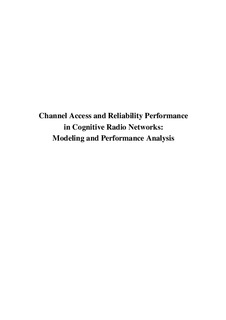Channel Access and Reliability Performance in Cognitive Radio Networks:Modeling and Performance Analysis
Doctoral thesis, Peer reviewed
Permanent lenke
http://hdl.handle.net/11250/2413948Utgivelsesdato
2016Metadata
Vis full innførselSamlinger
- Doctoral Dissertations [378]
Sammendrag
According to the facts and figures published by the international telecommunication
union (ITU) regarding information and communication technology (ICT)
industry, it is estimated that over 3.2 billion people have access to the Internet in
2015 [1]. Since 2000, this number has been octupled. Meanwhile, by the end of
2015, there were more than 7 billion mobile cellular subscriptions in the world, corresponding
to a penetration rate of 97%. As the most dynamic segment in ICT,
mobile communication is providing Internet services and consequently the mobile broadband penetration rate has reached 47% globally. Accordingly, capacity,
throughput, reliability, service quality and resource availability of wireless services
become essential factors for future mobile and wireless communications. Essentially,
all these wireless technologies, standards, services and allocation policies
rely on one common natural resource, i.e., radio spectrum.
Radio spectrum spans over the electromagnetic frequencies between 3 kHz and
300 GHz. Existing radio spectrum access techniques are based on the fixed allocation
of radio resources. These methods with fixed assigned bandwidth for exclusive
usage of licensed users are often not efficient since most of the spectrum
bands are under-utilized, either/both in the space domain or/and in the time domain.
In reality, it is observed that many spectrum bands are largely un-occupied
in many places [2], [3]. For instance, the spectrum bands which are exclusively allocated
for TV broadcasting services in USA remain un-occupied from midnight to
early morning according to the real-life measurement performed in [4]. In addition
to the wastage of radio resources, spectrum under-utilization constraints spectrum
availability for other intended users. Furthermore, legacy fixed spectrum allocation
techniques are not capable of adapting to the changes and interactions in the system,
leading to degraded network performance.
Unlike in the static spectrum allocation, a fraction of the radio spectrum is
allocated for open access as license-free bands, e.g., the industrial, scientific and
medical (ISM) bands (902-928, 2400-2483.5, 5725-5850 MHz). In 1985, the federal
communications commission (FCC) permitted to use the ISM bands for private
and unlicensed occupancy, however, under certain restrictions on transmission
power [5]. Consequently, standards like IEEE 802.11 for wireless local area networks
(WLANs) and IEEE 802.15 for wireless personal area networks (WPAN)
have grown rapidly with open access spectrum policies in the 2.4 GHz and 5 GHz
ISM bands. With the co-existence of both similar and dissimilar radio technologies,
802.11 networks face challenges for providing satisfactory quality of service (QoS).
This and the above mentioned spectrum under-utilization issues motivate the spectrum
regulatory bodies to rethink about more flexible spectrum access for licenseexempt
users or more efficient radio spectrum management. Cognitive radio (CR) is
probably the most promising technology for achieving efficient spectrum utilization
in future wireless networks.
Beskrivelse
Doktorgradsavhandling ved Institutt for Informasjons- og kommunikasjonsteknologi, Universitetet i Agder

